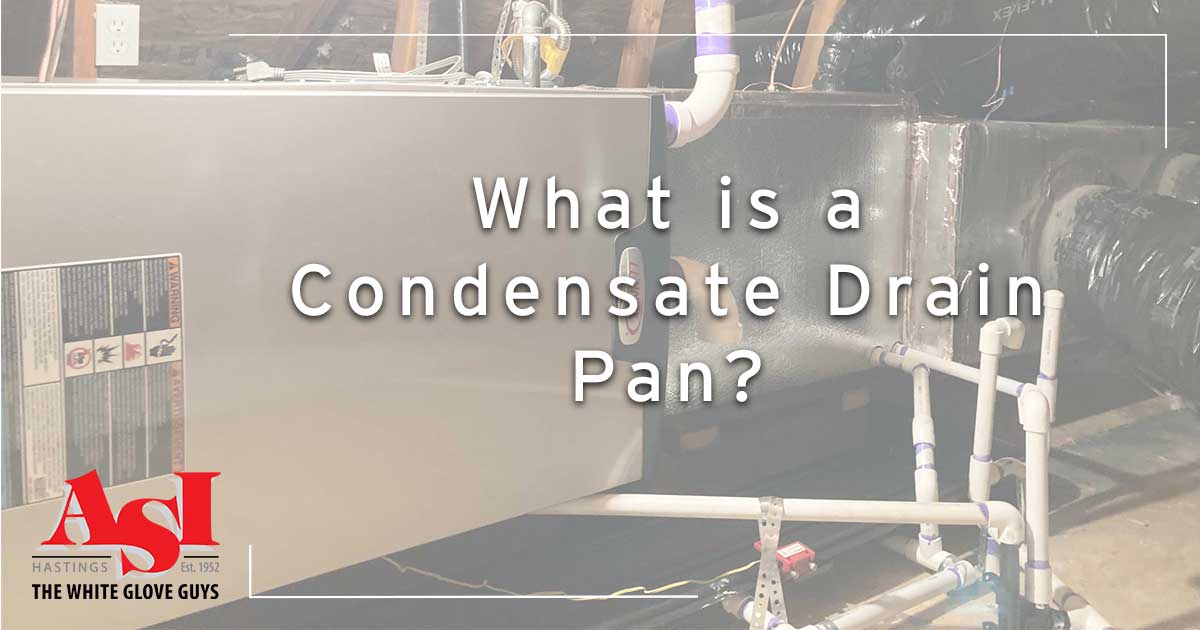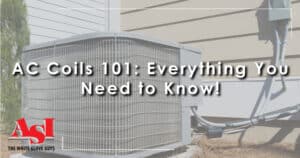When we say condensate drain pan, most homeowners have no idea what we’re talking about. That’s because this little part plays a big role in the overall health and safety of your HVAC system.
Without the condensate drain pan, you could be looking at a lot of water damage to your home and HVAC system, today we’re explaining what it is and why it’s so important.
How does a condensate drain pan work?
One of an air conditioner’s main jobs is to remove condensation from the air. That’s why your home doesn’t feel like you live in the middle of tropical jungle.
The condensate drain pan catches all that humidity and excess water that is removed from your air. It also makes sure the water is safely disposed of outside the home.
As your HVAC system cools the air, the evaporator coil fills with refrigerant and makes that refrigerant very cold. Through heat transfer, the warmth in your home’s air is transferred to the cold refrigerant.
This process can create a lot of condensation. Think of an ice water that’s been taken outside. All those drops of water need to go somewhere.
This is why we have the condensate drain pan. It catches all those beads of water and makes sure everything is deposited into a waste tube. The waste tube sends the water outside.
Depending on how much you use the AC, it can generate between 5 and 20 gallons of condensation per day.
Where is the condensate drain pan located?
The condensate drain pan is not a standalone part. It’s part of the evaporator coil. How it functions depends on the type of furnace you have and where your furnace is located.
Vertical furnace installation or application
- These furnaces are in an upright position and run air up and down. Therefore, they only need one condensate drain pan because any water leaks are only going in one direction. These types of furnaces are normally found in utility closets and garages.
Horizontal furnace installation or application
- Most attic furnaces are horizontal. Air moves side to side in this model, so water has the potential to drip all over the unit, not just in once concentrated place. The condensate drain pan sits under the evaporator coil, but these furnaces also have a secondary drain pan.
Why does the horizontal application have a second drain pan?
For horizontal furnaces, two pans are better than one. This is for the safety of your system and your home.
When something goes wrong with a horizontal furnace, the potential for spillage is much higher than a vertical furnace. Keep this in mind when we remind you that a single air conditioner system can generate up to 20 gallons of condensation per day.
The secondary drip pan is in place if something goes wrong with the primary one. It also has a waste line. However, this waste line drains water outside your home in a very obvious way to alert you that you need to shut down your system and call for help.
How does the condensate drain pan get damaged?
Unfortuantely, just like any other part, the condensate drain pan can fail. Most of the time the pan develops cracks.
Older drain pans were made from metal. This doesn’t work when holding water. The water would corrode the drain pan, leaving holes and cracks in its wake.
Modern drain pans are made of a durable plastic and now have a lifespan of 5 to 10 years. The only problem is that they’re directly attached to the evaporator coil. If you need to replace the condensate drain pan, you’re replacing the entire evaporator coil.
What damages the condensate drain pan?
This sounds a little counterintuitive, but the heating process can also damage the condensate drain pan.
During the summer, the drain pan stays nice and moist. It doesn’t dry out. This changes during the winter. Warm bursts of air over and over again can wear out the drain pan and make it crack. No matter what material the pan is made from.
A cracked pan can’t hold water. Instead, during the spring and summer, the pan will drip water into the furnace or allow water to pool at the bottom of the evaporator coil.
Another big cause of drain pan failure is clogs in the waste line. This is usually attributed to an overfull air filter.
When the air filter is too full, it can’t trap dust that has the potential to clog the waste line. This is a big problem because the condensate drain pan is shallow.
It’s not made to hold a lot of water. The drain pan was made to be constantly cycling water, not holding still water. When a line is backed up, water can overflow into the furnace.
A clogged condensate line, a cracked condensate drain pan, or a soggy furnace can lead to many unwanted issues. This includes:
- Microbiological growth
- Safety hazards
- Low indoor air quality
- Internal buildup
- AC repairs
- Higher energy expenditure
- Smelly air
- Water damage to the home
Water gathering anywhere in your HVAC system can present a serious threat to the health and safety of your system and your home. If you suspect this, call an HVAC professional as soon as possible.
Care for Your Entire HVAC System with the Experts at ASI
ASI, the White Glove Guys know our way around an HVAC System. We’ve been doing it since the 1950s and we’re planning on doing it as long as possible.
Our HVAC experts are ready to help with any question or concern you may have. Simply call the number at the top of the screen or click here to request an appointment online.














